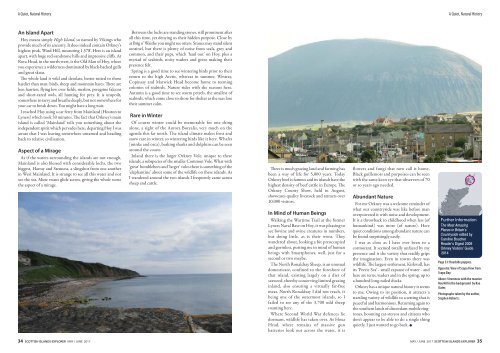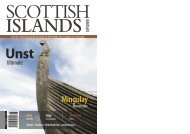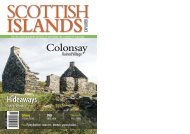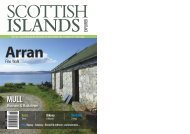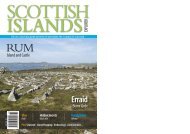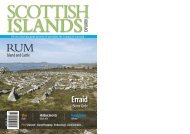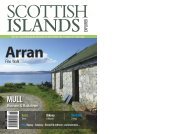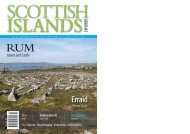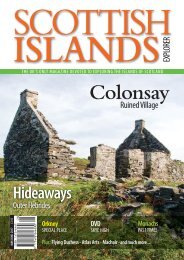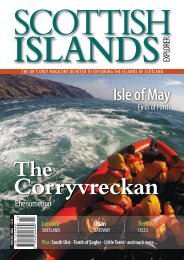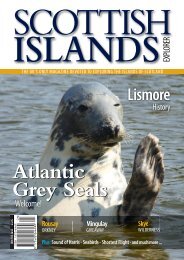Create successful ePaper yourself
Turn your PDF publications into a flip-book with our unique Google optimized e-Paper software.
A Quiet, Natural History<br />
A Quiet, Natural History<br />
An Island Apart<br />
Hoy means simply High Island, so named by Vikings who<br />
provide much of its ancestry. It does indeed contain Orkney’s<br />
highest peak, Ward Hill, measuring 1,578'. Here is an island<br />
apart, with huge red-sandstone hills and impressive cliffs. At<br />
Rora Head, in the north-west, is the Old Man of Hoy, where<br />
you experience a wilderness dominated by black-backed gulls<br />
and great skuas.<br />
The whole land is wild and desolate, better suited to those<br />
hardier than man: birds, sheep and mountain hares. There are<br />
hen harriers, flying low over fields, merlins, peregrine falcons<br />
and short-eared owls, all hunting for prey. It is unspoilt,<br />
somewhere to tarry and breathe deeply, but not somewhere for<br />
your car to break down. You might have a long wait.<br />
I reached Hoy using a car ferry from Mainland (Houton to<br />
Lyness) which took 30 minutes. The fact that Orkney’s main<br />
island is called ‘Mainland’ tells you something about the<br />
independent spirit which pervades here; departing Hoy I was<br />
aware that I was leaving somewhere untamed and heading<br />
back to relative civilisation.<br />
Aspect of a Mirage<br />
As if the waters surrounding the islands are not enough,<br />
Mainland is also blessed with considerable lochs, the two<br />
biggest, Harray and Stenness, a slingshot from one another<br />
in West Mainland. It is strange to see all this water and not<br />
see the sea. Mute swans glide across, giving the whole scene<br />
the aspect of a mirage.<br />
Between the lochs are standing stones, still prominent after<br />
all this time, yet denying us their hidden purpose. Close by<br />
at Brig o’ Waithe you might see otters. Stones may stand silent<br />
sentinel, but there is plenty of noise from seals, grey and<br />
common, and their pups, which ‘haul out’ on Hoy, plus a<br />
myriad of seabirds, noisy waders and geese making their<br />
presence felt.<br />
Spring is a good time to see wintering birds prior to their<br />
return to the high Arctic, whereas in summer, Westray,<br />
Copinsay and Marwick Head become home to teeming<br />
colonies of seabirds. Nature rides with the seasons here.<br />
Autumn is a good time to see storm petrels, the smallest of<br />
seabirds, which come close to shore for shelter as the seas lose<br />
their summer calm.<br />
Rare in Winter<br />
Of course winter could be memorable for one thing<br />
alone, a sight of the Aurora Borealis, very much on the<br />
agenda this far north. The island climate makes frost and<br />
snow rare in winter, so wintering birds like it here. Whales<br />
(minke and orca), basking sharks and dolphins can be seen<br />
around the coasts.<br />
Inland there is the larger Orkney Vole, unique to these<br />
islands, a subspecies of the smaller Common Vole. What with<br />
‘great’ bumblebees and ‘larger’ voles there is something of the<br />
‘elephantine’ about some of the wildlife on these islands. As<br />
I wandered around the two islands I frequently came across<br />
sheep and cattle.<br />
There is much grazing land and farming has<br />
been a way of life for 5,000 years. Today<br />
Orkney beef is famous and its islands have the<br />
highest density of beef cattle in Europe. The<br />
Orkney County Show, held in August,<br />
showcases quality livestock and attracts over<br />
10,000 visitors.<br />
In Mind of Human Beings<br />
Walking the Wartime Trail at the former<br />
Lyness Naval Base on Hoy, it was pleasing to<br />
see bovine and ovine creatures in numbers,<br />
but doing little, as is their wont. They<br />
wandered about, looking a bit preoccupied<br />
and gormless, putting me in mind of human<br />
beings with Smartphones, well, just for a<br />
second or two maybe.<br />
The North Ronaldsay Sheep, is an unusual<br />
domesticate, confined to the foreshore of<br />
that island, existing largely on a diet of<br />
seaweed, thereby conserving limited grazing<br />
inland, also ensuring a virtually fat-free<br />
meat. North Ronaldsay I did not reach, it<br />
being one of the outermost islands, so I<br />
failed to see any of the 3,700 odd sheep<br />
roaming here.<br />
Where Second World War defences lie<br />
dormant, wildlife has taken over. At Hoxa<br />
Head, where remains of massive gun<br />
batteries look out across the water, it is<br />
flowers and fungi that now call it home.<br />
Black guillemots and porpoises can be seen<br />
with the same keen eye that observers of 70<br />
or so years ago needed.<br />
Abundant Nature<br />
For me Orkney was a welcome reminder of<br />
what our countryside was like before man<br />
overpowered it with noise and development.<br />
It is a throwback to childhood when less (of<br />
humankind) was more (of nature). Here<br />
quiet conditions among abundant nature can<br />
be found surprisingly easily.<br />
I was as close as I have ever been to a<br />
cormorant. It seemed totally unfazed by my<br />
presence and is the variety that readily grips<br />
the imagination. Even in towns there was<br />
wildlife. The largest settlement, Kirkwall, has<br />
its ‘Peerie Sea’ - small expanse of water - and<br />
here are terns, waders and in the spring, up to<br />
a hundred long-tailed ducks.<br />
Orkney has a unique natural history it seems<br />
to me. Owing to its position, it attracts a<br />
startling variety of wildlife to a setting that is<br />
peaceful and harmonious. Returning again to<br />
the southern lands of discordant mobile ringtones,<br />
booming car-stereos and citizens who<br />
don’t appear to be able to do a single thing<br />
quietly, I just wanted to go back.<br />
Further Information<br />
The Most Amazing<br />
Places in Britain’s<br />
Countryside edited by<br />
Caroline Boucher<br />
Reader’s Digest 2009<br />
Orkney Visitors’ Guide<br />
2014<br />
Page 33: Roadside poppies.<br />
Opposite: View of Scapa Flow from<br />
Scapa Bay.<br />
Above: Stromness with the massive<br />
Hoy Hill in the background by Rae<br />
Slater.<br />
Photographs taken by the author,<br />
Stephen Roberts.<br />
34 SCOTTISH ISLANDS EXPLORER MAY / JUNE <strong>2017</strong><br />
MAY / JUNE <strong>2017</strong> SCOTTISH ISLANDS EXPLORER 35


